Coronavirus Higher Education Industry Briefing: March 24

Media Coverage Shifts to Campus Experts
Today’s Briefing analyzes publicly available online conversation about coronavirus and higher education from March 20–23. In this analysis of volume, topics, sentiment, and key audiences, we highlight changing campus news coverage, trending hashtags (some may surprise you), and continuing expression of anger and sadness from students. Since the March 17 Briefing, we haven’t made any changes to our data collection. We have, however, improved our categorization of family and friend mentions; you’ll see a comparison of their expression of emotion in this Briefing.
If you’d like to receive each Briefing in your inbox as soon as we publish it, sign up at info.campussonar.com/covid19. You can also review all prior Briefings. Because of the changing nature of social media data and our understanding of the conversation, each Briefing covers a distinct point in time. Comparisons among Briefings may be helpful, but we can’t draw correlations like we could if we were using other datasets such as surveys or historical social media data.
Conversation Exhibits Predictable Weekday/Weekend Patterns
Volume decreased as we entered the weekend but increased again on Monday. Similar to our observation in the March 17 Briefing (which covered March 13–16), it seems we’ve entered a standard cadence of conversation volume we regularly see in higher education. Friday–Sunday has the least conversation and Monday–Thursday produces more.
There were about 460,00 mentions of higher education and the coronavirus March 20–23, ranging from 80,000–172,000 per day. Remember, our industry-level analysis only captures general higher education mentions. If someone mentions the name or acronym of an institution without using a higher ed term (e.g., campus, university, college, classes, etc.), it’s not included in this analysis. Actual volume of conversation across the industry is likely much higher.
Of the 460,000 mentions we identified, 33 percent were higher education-focused.
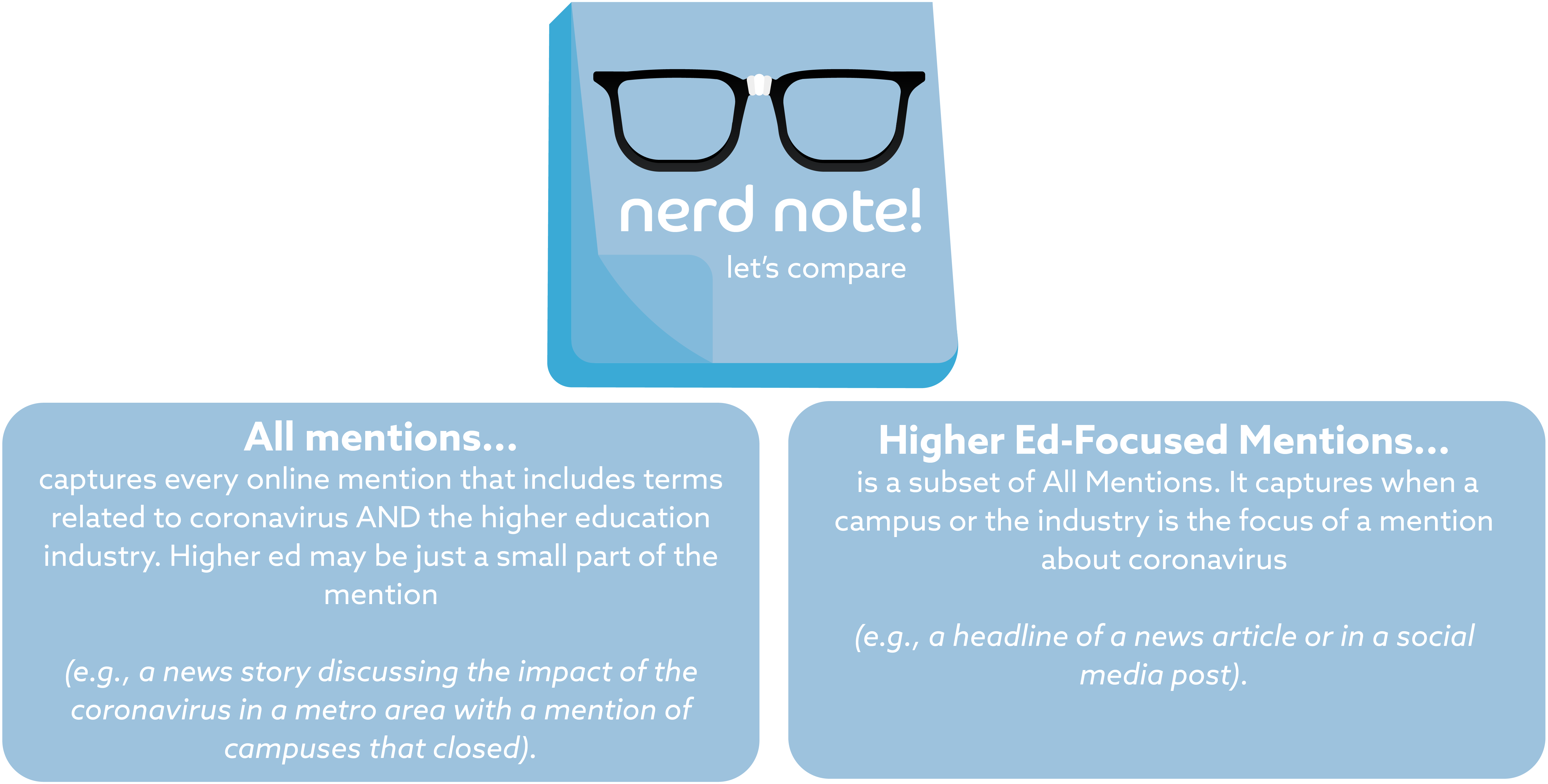
News Coverage Showcased Campus Experts
Social media is still the dominant source of conversation about higher ed and the pandemic. 86 percent of higher ed-focused mentions are on social media, with another 8 percent on forums and 5 percent on Tumblr. Just one percent of higher ed-focused mentions appear in the news.
Although there was comparably little news coverage (we identified ten times less higher ed-focused news than a week ago in the March 17 Briefing), the topic trends are interesting. The following chart shows fading and trending topics for March 20–23. Public health and the names of campus experts like Lawrence Gostin of Georgetown University, Tamara Hew-Butler and Mariane Fahlman of Wayne State University, and Jonathan Heidt of the University of Missouri Healthcare are starting to trend. While not pictured on the chart, Emily Landon, the chief infectious disease epidemiologist at the University of Chicago Medicine trended in our larger dataset after her speech at a March 20 news conference garnered attention in both social and traditional media.
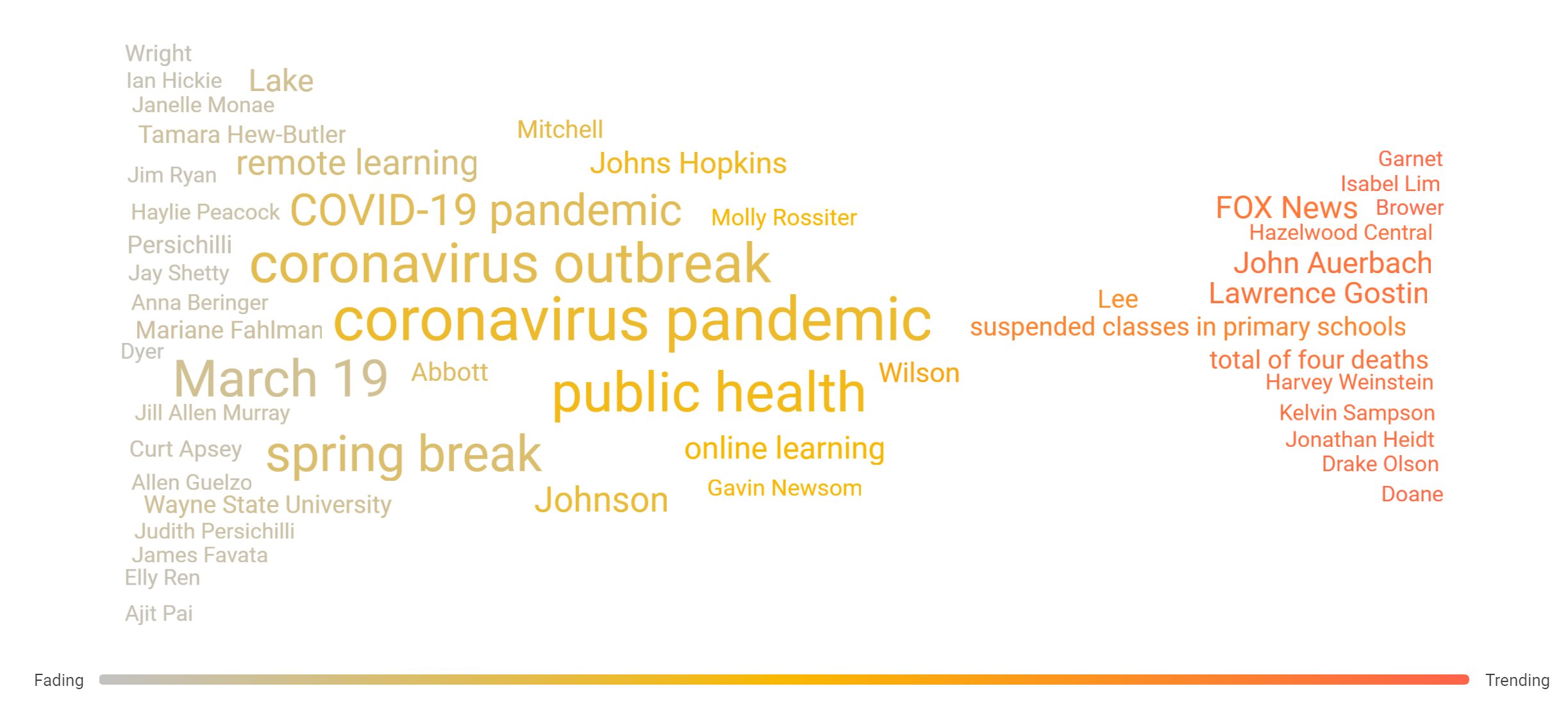
The media has moved on from the immediate news of campus closures and online instruction to topics such as Stay At Home orders, federal stimulus legislation, and economic impacts. Now, when colleges and universities are mentioned in the media it’s more likely to be alongside expert commentary, a campus offering testing centers, or a health center providing care. The coverage of Wayne State University faculty in multiple news outlets stemmed from their piece in The Conversation about exercising during the pandemic, demonstrating how faculty willing to write from their expertise can garner news coverage that is both helpful to the public and positive press for the campus.
Hashtags and Topics Represent Diverse Conversations
As people work and learn from their homes, their experiences, thoughts, and opinions diversify. A review of the top 100 hashtags and 100 topics from March 20–23 demonstrates this diversity of experience.
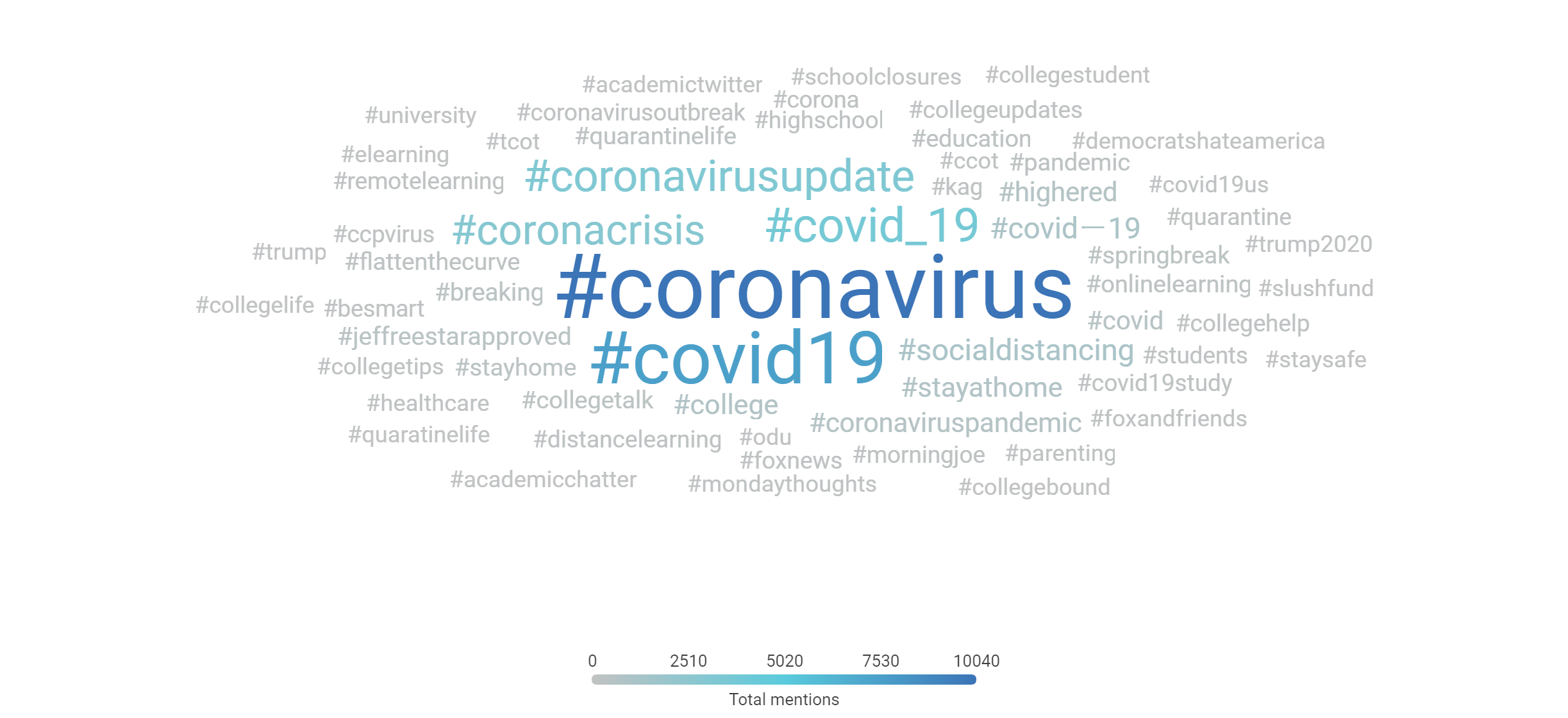
While the most common hashtags still focus on the coronavirus, you’ll see a proliferation of related hashtags that span various topic areas.
- Learning (e.g., #eLearning, #RemoteLearning, #CollegeLife, #DistanceLearning)
- Public health (e.g., #StayAtHome, #QuarantineLife, #FlattenTheCurve, SocialDistancing)
- Politics (e.g., #SlushFund, #Trump2020, #DemocratsHateAmerica)
- Academia (e.g., #AcademicTwitter, #AcademicChatter)
A few campus-specific hashtags have been mentioned enough to make the top hashtag list: #ODU from Old Dominion University and #FinishStrongFSU from Florida State.
One hashtag on that list might make you scratch your head: #JeffreeStarApproved. This surfaced as the thirteenth most used hashtag in higher ed-focused mentions in response to Jeffree’s tweet offering to help people in need. It received many responses from students and their family members dropping their Cash App payment link and sharing stories of being unable to work to afford school. Jeffree is a popular YouTube star, who rose to fame for makeup videos and now has a popular makeup line—and over 17 million YouTube subscribers.
The top 100 topics, phrases, people, and emojis makes clear there’s not a common feeling or sentiment when talking about higher ed and the coronavirus.

In addition to the expected topics of online classes, college students, and spring break we’ve seen in prior briefings, “sign the petition” had almost 5,000 mentions March 20–23. Petitions were circulated for many campuses (so if you saw one, know you’re not alone). Most often they requested pass/fail grading, but a few sought refunds for fees due to a change in campus operations and a loss of housing.
“Vanderbilt University” and “parking garage” surfaced as top topics when a picture of a campus parking garage being prepped to hold COVID-19 patients circulated on Twitter starting March 20. The media reported on it March 21 after university officials confirmed the parking lot was being prepped for assessment, not patient care.
The vast range of emojis illustrates the variety of emotions expressed the last few days. Top emojis include laughing while crying, crying from sadness, virus, and swearing angry face.
Sentiment Remains Negative, More So for Students
Sentiment from higher ed-focused conversation is consistent with our last Briefing—26 percent negative and 8 percent positive. Students and their families discussing their first-person experiences remain more negative than the general conversation, with 42 percent positive sentiment. However, they also have more positive conversations; 17 percent of the conversation is positive. Students on Reddit remain the most negative, with 52 percent negative sentiment. This variation in sentiment can be partially explained by the emotional analysis we’ll share later in this Briefing.
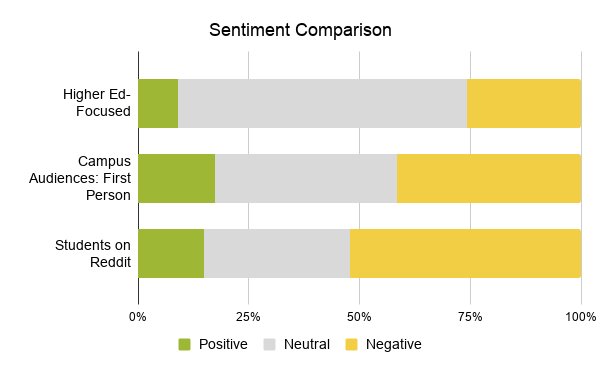 Audience Insights: Focus on Hidden Voices of Students
Audience Insights: Focus on Hidden Voices of Students
When the conversation is this large, it’s hard to find the individual voices. While over 139,000 individual accounts are contributing to higher ed-focused conversation, only 6 percent of the mentions are first-person accounts from individuals who reveal an affiliation with a campus. These hidden voices represent lived experiences that provide valuable insight as you craft your communication and service delivery.
We’re still finding the most conversation from students, and a small but not insignificant amount of conversation from their family and friends. Admitted students and alumni aren’t showing up often in our audience analysis, either because they’re not discussing general higher education terms in relation to coronavirus or they’re having discussions on platforms we can’t access through social listening. Although there are some fun false positives for admitted students as people proclaim they’ve been accepted to Zoom University.
Students Share Experiences on Multiple Sites
Since we started these Briefings, the source of student conversation has continued to change. First, we were surprised by the volume of conversation on Tumblr. Then we saw Reddit enter the conversation. Now, we see an almost even distribution of conversation on social media (mostly Twitter), Forums (often Reddit), and Blogs/Tumblr. Remember that due to data access restrictions, we aren’t including Facebook, Instagram, Snapchat, TikTok, or LinkedIn in our analysis. Your campus social media manager is the best source of information regarding conversation on those networks. As an aside, though, social listening for a specific campus can include Facebook and Instagram mentions once account managers verify admin access.
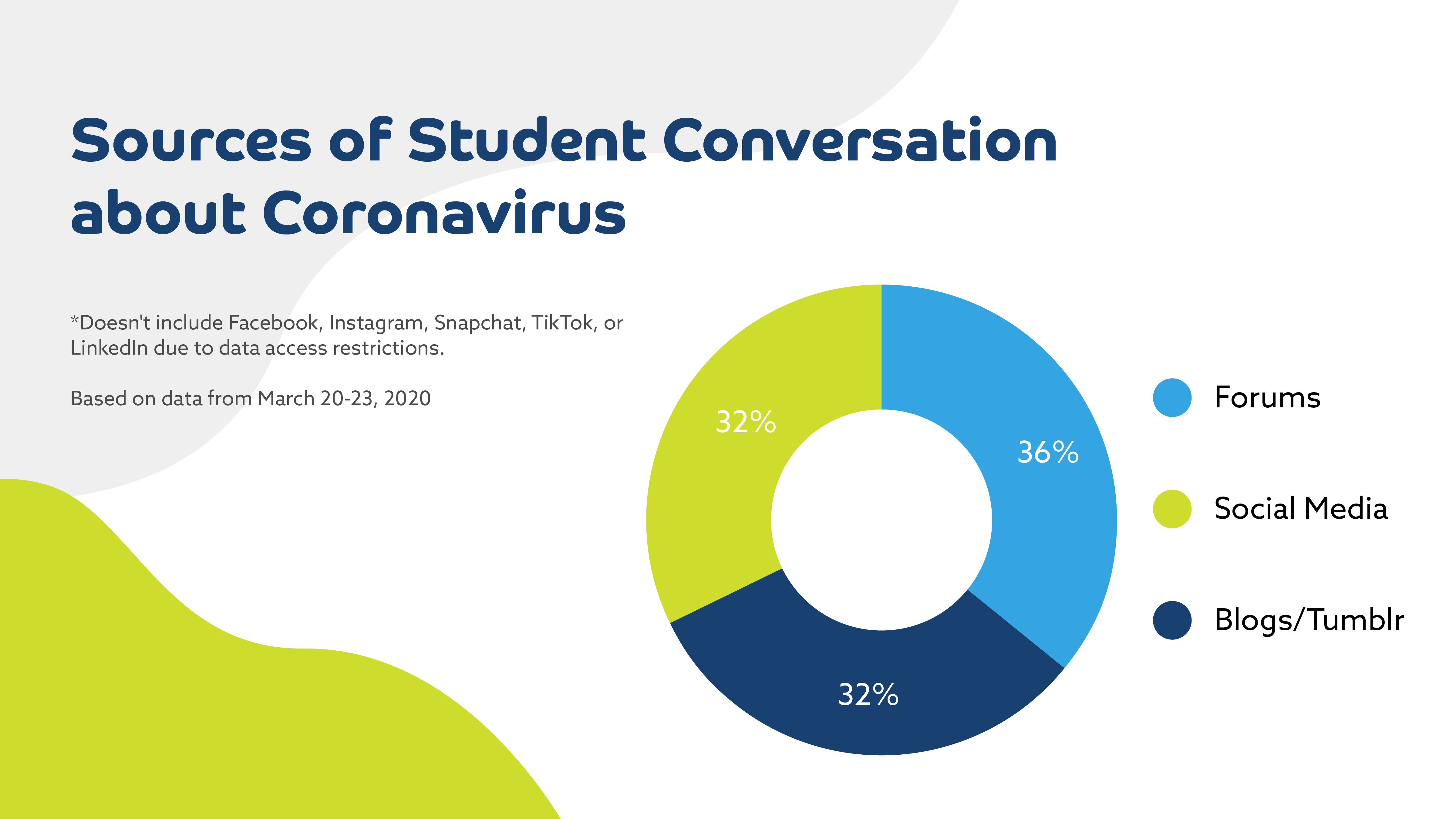
It appears the platform dictates the type of conversation. Social media conversation is all over the place—including memes, mundane updates, reports from online classes, and life musings. About half of Tumblr posts shared viral posts (we explored this in our March 17 Briefing, in the Student Perspectives Spread Via Word of Mouth section). The rest are “day in the life” updates, written as if they’re entries in a journal read by a few friends.
Reddit is where it gets real. Students have more characters and the safety of anonymity (whether perceived or real), and they discuss very serious topics.
Students Remain Angry and Sad
Of the more than 7,000 posts from students expressing emotion, 78 percent expressed anger or sadness. Family and friends are angry and sad too, but less so—54 percent of their posts express those emotions, and they’re more sad than angry.
For both populations, sadness stems from grief about aspects of student life that have been lost. (This was described well in a March 23 Harvard Business Review article, “That Discomfort You’re Feeling is Grief.”) Students are grieving graduation, time with friends, budding romantic relationships now left behind, and dealing with loneliness. You’re likely experiencing some of this grief yourself as a campus professional.
Especially on Reddit, there are some vulnerable and concerning posts about mental health. This is not new in times of a pandemic; we’ve seen students use Reddit as a mental health resource before. One particular post that caught my attention was published on Monday, March 23 to a campus-specific subreddit. The title is “Does anyone feel completely uncared for at <campus> due to the pandemic?” Within 24 hours, it received over 100 comments. None of the replies come from anyone who has “flair” verifying they work for the university. In fact, the only flair in that thread is a verified 2019 graduate who did not offer the student help in their response.
If your campus or city has a subreddit, you should monitor it for cries for help like this as well as general campus community feedback. If you need help understanding Reddit (including figuring out what the heck flair is), Campus Sonar’s Steve App wrote an excellent explainer for Inside Higher Ed last fall, including his five rules for engagement on Reddit.
Conversations aren’t just happening in your campus subreddit; these may be harder for you to find (and one of the reasons we continue to publish this Briefing). A lot of the student posts expressed anger in response to the Reddit thread, When did COVID-19 get real for you?. Although this thread generated over 28,000 comments in less than 24 hours, a glance through it or a ctrl+f search for key terms provides some unfiltered experiences from people everywhere; students are mixed in.
Many student posts expressed anger about the move to online courses. Specifically:
- Not knowing what’s going on (some students hadn’t heard from professors).
- Not having good enough computers to access course materials.
- General technology issues.
- A general disdain for taking courses online.
Family and Friends Had Moments of Joy
I was surprised to see that 32 percent of family and friend conversation expressed joy. After reviewing the trends in those mentions, it made sense. This analysis included Friday–Monday, and some of the joyful mentions described activities over the weekend that allowed them to connect with their family or other people even though students were unexpectedly home from college. Other joyful expressions included:
- Parents who are proud of how their students are helping during the pandemic (many are medical or nursing students, or work in university hospitals).
- A sense of joy or relief after picking children up from campus.
- Great things university staff and faculty are doing to help students.
Summary and Recommendations
It appears we’ve entered a cadence of conversation volume similar to what we regularly see in higher education, although overall volume remained elevated. Friday–Sunday had the least conversation and Monday–Thursday produced more. News coverage shifted to showcase campus experts and faculty contributions relevant to the pandemic, rather than focusing on changes to campus operations. Online conversation started to diverge to multiple topic areas that all referenced higher ed and the coronavirus: learning and working online, public health initiatives, politics, and initiatives from specific campus communities. Students and community members circulated petitions for multiple campuses requesting pass/fail grades or fee refunds. While negative sentiment was about as expected for a crisis at the industry-level, negativity increases as mentions become more personal (this hasn’t changed since our last Briefing). Students continue to share their experiences, most often reflecting anger and sadness. They shared on a variety of sites; we found similar amounts of student conversation on Twitter, Tumblr, and Reddit.
Recommendations from today’s briefing apply to multiple campus units: faculty, media relations, student affairs, and—of course—social media managers.
- Faculty and Media Relations: News coverage of higher education and the pandemic shifted to focus on expert voices. Faculty members with a variety of expertise (e.g, public health, economics, mental health, human behavior) can offer valuable information to the public as we grapple with an economic crisis while being confined to our homes. Encourage faculty to share their expertise on blogs, Twitter, or other easy-to-access sites (like Wayne State faculty did in The Conversation). Media relations staff can share that content with journalists or amplify it with campus social media accounts so your institution has a positive contribution to the coronavirus news cycle.
- Student Affairs: Students need support now more than ever. They’ve expressed mental health concerns, struggles accessing courses, and grief over lost experiences. If you’ve transitioned key support services online, make sure your campus communicators are aware so they can share helpful information when they find a student in distress. While it’s nice to share information from the campus health center or academic support center, the manager of central campus web pages and social media accounts should also have this information handy. If you’re able, browse your campus or city subreddit to get an unfiltered glimpse into concerns students share with their peers.
- Social Media Manager: First, take a breath. You’ve been through a lot this month. Then, consider how you can martial campus partners (like student affairs) to help triage the needs of students during this time—while also responding to requests from administration. If you’re the only one doing this job, it’s unlikely you can monitor every single social media site for mentions from students in need. Enlist help. Can colleagues help you monitor Reddit? Is there a student employee doing work-from-home that can help on TikTok, or Instagram? Figure out how to distribute your workload now, as it’s likely to continue at an elevated level for a while. And if you haven’t yet, work with your manager to ensure your helpers are trained to take over the flagship social media accounts if you get sick or need a break for a few days—one of those things is bound to happen.
Stay Connected with Future Briefings
The Coronavirus Higher Education Industry Briefing is new territory for Campus Sonar. If you find it valuable, please let us know (tweet us at @CampusSonar, email info@campussonar.com, or comment on this post).
Do you have additional questions about the conversation you’d like us to consider for a future briefing? Let us know.
We’ll be back on Friday with our next briefing. Now that many of us are staying at home, don’t forget to turn off your computer or put your phone down for a few minutes or hours. The internet will be there when you return.

